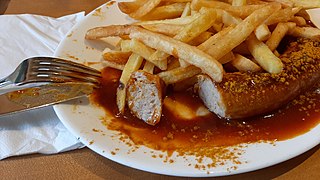
Pigs in a blanket in the United States is a small hot dog or other sausage wrapped in pastry similar to a 'sausage roll' in the UK, it is commonly served as an appetizer in the United States. The similarity in name with that of the UK dish pigs in blankets, which is a sausage wrapped in bacon, sometimes causes confusion.

A blood sausage is a sausage filled with blood that is cooked or dried and mixed with a filler until it is thick enough to solidify when cooled. Most commonly, the blood of pigs, sheep, lamb, cow, chicken, or goose is used.

A fried egg is a cooked dish made from one or more eggs which are removed from their shells and placed into a frying pan and fried. They are traditionally eaten for breakfast in many countries but may also be served at other times of the day.

Scrapple, also known by the Pennsylvania Dutch name Pannhaas, is traditionally a mush of pork scraps and trimmings combined with cornmeal and wheat flour, often buckwheat flour, and spices. The mush is formed into a semi-solid congealed loaf, and slices of the scrapple are then pan-fried before serving. Scraps of meat left over from butchering, not used or sold elsewhere, were made into scrapple to avoid waste. Scrapple is primarily eaten in the southern Mid-Atlantic region of the United States.

Danish cuisine originated from the peasant population's own local produce and was enhanced by cooking techniques developed in the late 19th century and the wider availability of goods during and after the Industrial Revolution. Open sandwiches, known as smørrebrød, which in their basic form are the usual fare for lunch, can be considered a national speciality when prepared and garnished with a variety of ingredients. Hot meals are typically prepared with meat or fish. Substantial meat and fish dishes includes flæskesteg and kogt torsk with mustard sauce and trimmings. Ground meats became widespread during the industrial revolution and traditional dishes that are still popular include frikadeller, karbonader and medisterpølse. Denmark is known for its Carlsberg and Tuborg beers and for its akvavit and bitters, but amongst the Danes themselves imported wine has gained steadily in popularity since the 1960s.

Fried rice is a dish of cooked rice that has been stir-fried in a wok or a frying pan and is usually mixed with other ingredients such as eggs, vegetables, seafood, or meat. It is often eaten by itself or as an accompaniment to another dish. Fried rice is a popular component of East Asian, Southeast Asian and certain South Asian cuisines, as well as a staple national dish of Indonesia. As a homemade dish, fried rice is typically made with ingredients left over from other dishes, leading to countless variations. Fried rice first developed during the Sui Dynasty in China.

Trinidad and Tobago has a unique history and its food is influenced by Indian-South Asian, West African, Creole, European, American, Chinese, Amerindian, and Latin American culinary styles. Trinidad and Tobagonian food is dominated by a wide selection of seafood dishes, most notably, curried crab and dumplings. Trinidad and Tobago is also known for its prepared provisions, such as dasheen, sweet potato, eddoe, cassava, yam, soups and stews, also known as blue food across the country. Corresponding to the Blue Food Day event held annually in Trinidad and Tobago.

Currywurst is a fast food dish of German origin consisting of steamed, fried sausage, usually pork, typically cut into bite-sized chunks and seasoned with curry ketchup, a sauce based on spiced ketchup or tomato paste topped with curry powder, or a ready-made ketchup seasoned with curry and other spices. The dish is often served with chips.

Nasi goreng is a Southeast Asian fried rice dish from Malay Archipelago. Nasi goreng is one of Indonesia's national dishes, and also a common dish in countries such as Malaysia, Singapore and Brunei. Nasi goreng has gained popularity in Sri Lanka through migrations from the Malay Archipelago, in countries like Suriname via Indonesian immigrant communities, and in the Netherlands through its colonial ties with Indonesia. Nasi goreng is distinguished from other Asian fried rice preparations by its distinct smoky aroma, and caramelised yet savoury undertones of flavour. There is no single defined recipe for nasi goreng, and its composition and preparation varies greatly from household to household.

Different areas of the world have local variations on the hot dog, in the type of meat used, the condiments added, and its means of preparation.

Turnip cake is a Chinese dim sum dish. The less commonly used radish cake is a more accurate name, as Western-style turnips are not used in the dish but rather shredded radish and plain rice flour. It is traditionally called carrot cake in Singapore.

Porilainen is a sandwich and street food dish in Finnish cuisine made from white bread and a thick slice of sausage, normally jagdwurst. Additional ingredients may include diced sweet onion, chopped pickled cucumber, ketchup, mustard, and in some cases mayonnaise or fried egg.

Regional street food is street food that has commonalities within a region or culture.

Naem is a pork sausage in Lao and Thai cuisine. It is a fermented food that has a sour flavor. It has a short shelf life, and is often eaten in raw form after the fermentation process has occurred. It is a popular Southeast Asian food, and different regions of Southeast Asia have various preferred flavors, including variations of sour and spicy. Naem is used as an ingredient in various dishes and is also served as a side dish.














